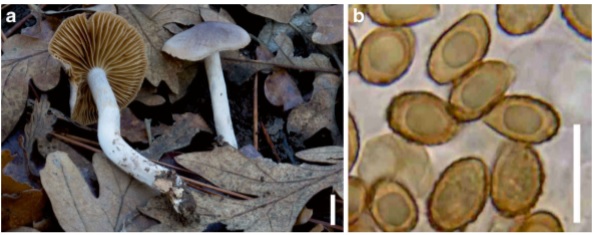Cortinarius albosericeus Ammirati, Beug, Liimat., Niskanen & O. Ceska
Index Fungorum number: IF 551701 Facesoffungi number: FoF 02037
Etymology: Name based on white thinly sheathing veil of stipe and pileus.
Holotype: Michael Beug 01MWB112013 (WTU) Pileus 30–40 mm diam., convex to broadly umbonate, silky dry, Mahogany Red to chestnut brown becoming Amber Brown then Tilleul Buff, margin white, hygrophanous. Lamellae adnate, subdistant, light pinkish cinnamon to cinnamon or cinnamon brown when mature, edge pale. Stipe 55– 80 mm long, 5–7 mm thick,±equal, slightly rooting, dry, apex sometimes with bluish tints, light vinaceous cinnamon to whitish buff. Universal veil white fibrillose, thinly sheathing the surface of the stipe with indistinct belts. Basal mycelium white. Context pale brown. Odour fungoid or slightly of radish. Taste slight fungoid to mild. Macrochemical reaction (40 % KOH): pileus context and surface clove brown, raw umber, bronze, stipe apex pinkish cinnamon to light ochraceous buff, stipe base warm buff to fuscous black. Exsiccatae: pileus margin light brown, disc darker brown, lamellae rust brown from spores, stipe pallid to light brown, white basal mycelium, context pallid to light brownish. Basidia 4-spored, 7–8.1×28–31μm, clavate, hyaline or slightly brownish. Basidiospores (7) 7.4–8.5×4.6–5.5μm (20 spores, holotype specimens), ellipsoid, broadly ellipsoid, or some amygdaloid, slightly to somewhat curved apiculus, moderately to coarsely verrucose, slightly to moderately or strongly dextrinoid. Lamella trama hyphae hyaline to yellowish brow nor brownish, walls yellow refractive, encrusted in KOH. Pileipellis in KOH: Surface layer thin, hyphae cylindrical, 4– 6μm wide, hyaline or rarely yellowish. Subtending layer of ±enlarged hyphae 8–30μm wide, hyaline, walls yellow refractive, hyaline to somewhat yellowish. Beneath a light yellow brown to light brown pigmented layer of cylindrical to enlarged hyphae, mostly 4–20μm wide that gradually grade into trama hyphae. ITS sequence distinct from the other known members of the Decipientes, and differs from them in the ITS region by more than 15 substitutions and indel positions.
Ecology and distribution: In mixed forests of Quercus garryana and Pinus ponderosa or Quercus garryana, Pseudotsuga and Arbutus menziesii. Producing basidiomata in late autumn. Known from British Columbia, Canada and Washington USA, Western North America.
Material examined: CANADA, British Columbia, Observatory Hill, Saanich, behind smaller dome, 48.52° N, 123.416° W, margin of mixed forest (Quercus garryana., Pseudotsuga menziesii, Arbutus menziesii) and open mossy rock outcrops on SW slope, 26 Nov 2005, leg. Oluna Ceska OC188,F17260 (UBC). USA, Washington. Klickitat County, Land Trust property, N45°44′20.65″W121°13′11.9″, Quercus garryana, 20 Nov 2013, leg. Michael Beug 01MWB112013 (holotype,WTU),(isotype,K(M):200657). Klickitat County, Wahkiacus, N45°49′20.6″W121°05′38.5″, Quercusgarryana and Pinus ponderosa, 20 Nov 2013, leg. Michael Beug 05MWB112013 (WTU, K).
Notes: Based on the phylogenetic analysis C. albosericeus belongs to clade Decipientes. The species in this clade are small and have chestnut brown to blackish brown pileus, white universal veil, and often some kind of smell in lamellae (cedar wood-like, spicy, or raphanoid). The stipe apex in almost all species sometimes has bluish tints. Cortinarius albosericeus is most similar to C. ohlone Bojantchev, but C. ohlone has cedar wood-like smell, nondextrinoid spores and occurs with coast live oak (Quercus agrifolia) and interior live oak (Q. wislizenii) in California.


